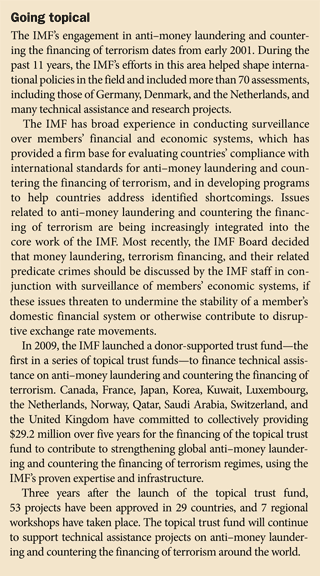Dirty Money, Real Pain
Finance & Development, June 2012, Vol. 49, No. 2
Money laundering harms innocent individuals but can also impose serious costs on national economies

CARTONS of cash in the Kabul airport, a strategically placed teller’s window just before immigration in Antigua, and some lines of code in accounting software in a bank in the Dominican Republic—seemingly unrelated phenomena, but all part of the global problem of money laundering. And all are linked to financial sector failures that led to real economic hardship for law-abiding citizens in the countries involved.
Money laundering is the process that transforms illegal inputs into supposedly legitimate outputs. Proceeds gained by crimes such as fraud, theft, and drug trafficking are made to look as if they were the fruits of honest hard labor—transformed, for instance, into legitimate-looking bank accounts, real estate, or luxury goods. This allows criminals to prosper from their crimes and live their lives without looking like criminals. Moreover, they can use these laundered proceeds to expand their criminal enterprises, thereby increasing their wealth and power, including the power to corrupt and buy protection from the political and law enforcement establishment.
If there were no fraud, no tax crime, no insider trading, no drug trafficking, no corruption, or indeed no proceeds-generating crime at all, there would be no money laundering. The close relationship between the criminal act that gives rise to proceeds and the laundering of these proceeds makes it very difficult to separate the act of money laundering from the underlying crime, although the two are treated legally as separate acts. Money laundering is an essential component of any profit-making crime, because without the laundering, crime really doesn’t “pay.”
When the underlying—or “predicate”—crime is something like drug trafficking, everyone understands the social costs, which are huge and visible. But the social and economic costs of white-collar crimes like embezzlement, tax evasion, insider trading, and bank fraud, while less obvious, can be massive as well.
Scary stories
For example, in August 2010, when the Afghan government intervened to replace the management of the country’s largest private bank, Kabul Bank, anxious depositors withdrew more than $200 million in deposits, in a bank run that threatened the country’s precarious financial and political stability. The bank, with the largest branch network in the country, was used to pay the security forces and other government workers, which made the threat of its collapse a matter of state concern.
Behind these events was a history of interest-free loans to bank insiders and politically connected parties, their subsequent illegal investments in foreign real estate, and mysterious planeloads of cash jetting from Kabul to Dubai—money laundering at 30,000 feet. A later investigation indicated that over $900 million—or more than 5 percent of the impoverished country’s GDP and 50 percent of its government’s budget—had been diverted from the bank. As of October 2011, more than a year after the government seized control of Kabul Bank, officials had recovered only a small portion of the missing money, and nobody has yet been criminally convicted. To date, Afghanistan’s central bank has spent almost $1 billion to bail out the banking sector, a huge cost for a country so poor.
The story in Antigua and Barbuda was different, but the consequences for that small island economy were also dire. U.S. fraudster Allen Stanford chose the island as the base for his massive Ponzi scheme, which marketed “high-yield” certificates of deposit on his Antigua-based bank to credulous investors in Miami and elsewhere (see “Perils of Ponzis” in the March 2010 issue of F&D). The purported high yields, of course, were not the result of some mystical market-beating investment that no other bank knew about.
Rather, the income from later investors went into paying returns to the earlier ones—except for the $1.6 billion that was diverted to support Stanford’s lavish lifestyle, including a special “Baby Mama Trust” in the Cook Islands for the mother of two of his children. In the meantime, while corrupting officials along the way, Stanford and his associates were laundering money by moving millions of dollars of fraudulently obtained investors’ funds from and among bank accounts outside the United States to various bank accounts in the United States.
And the teller’s window? Just a convenience for couriers from Miami with cash or checks to deposit who didn’t want their comings and goings registered in the country’s immigration system. They could just get off the plane, make a deposit, and then go back to the transit lounge and wait for their return flight.
When the whole scheme came tumbling down in 2009, as Ponzi schemes eventually do, it took with it Stanford’s bank—and most of the rest of the Antiguan economy, which was enmeshed in the growth of what had become the island’s biggest employer. That year, Antigua’s GDP shrunk by 9.6 percent; the Bank of Antigua came under the control of the regional central bank, from which it required a loan of 3 percent of the country’s GDP. Ultimately Antigua needed a $118 million program supported by the IMF. In March 2012, Stanford was convicted of defrauding 30,000 investors in 113 countries.
In the Dominican Republic, insiders at Banco Intercontinental, the second-largest private bank in the country, set up an elaborate scheme to loot the bank’s assets. They loaned money to themselves and secured loans from third parties with bank funds while concealing these nonperforming assets in a parallel set of books.
Every day for 14 years, an automated accounting program “balanced” the bank’s books by transferring real assets and liabilities between the two systems to make the “above-ground” bank look solvent. For example, the nonperforming related-party loans were eliminated from the bank’s formal asset accounts along with a group of balancing liabilities—say, a randomly selected group of long-term certificates of deposit that would not be missed. The next day, the program dumped those real liabilities back into the bank’s books and selected another group that balanced the concealed bad assets.
When the fraud finally came to light in 2003, “BANINTER” (as the bank was known) and two related commercial banks were bailed out by the government at a cost of 21 percent of the country’s GDP. The social and economic costs exceeded the direct cost of the bailouts; a rapid depreciation of the peso by approximately 65 percent led to very high inflation and a serious erosion of real incomes. Approximately 1.5 million Dominicans (about 16 percent of the population) fell below the poverty line in the aftermath of the banking crisis, 670,000 of whom fell into extreme poverty.
These stories, of course, do not exhaust the catalog of techniques that criminals use to conceal the origins of their wealth. Making cash deposits of the proceeds of crime is a basic money laundering technique. In countries like the United States, where banks are required to report cash deposits and withdrawals over $10,000, criminals often try to structure their deposits into many smaller amounts. Multiple intermediaries carrying this out at multiple banks came to be known as “smurfing,” because the frenetic activity of the faceless couriers reminded investigators of the characters in the eponymous popular cartoon series. And just as the little blue characters from the cartoon have moved from television, to computer games, and now to the movie screen, the term remains alive in the anti–money laundering world.
Highly sophisticated money laundering schemes often involve creating intricate layers of fictitious companies in multiple jurisdictions to conceal the actual criminal who owns and controls the assets. It is not unheard of for a money launderer to set up a trust in one jurisdiction whose sole purpose is to be the owner of shares in a holding company in an offshore center, with “subsidiaries” in third, fourth, and fifth countries whose only business is to open bank accounts the original party can then utilize anonymously. Such nontransparent offshore corporate entities were a centerpiece of the massive fraud committed by managers at the U.S. corporation Enron, who were indicted for money laundering as well as for the predicate fraud they committed.
Hitting the economy
The foregoing examples show how financial crimes such as corruption, tax crimes, financial fraud, and insider dealing—all predicate crimes to money laundering—can contribute to economic problems. The impact is felt especially in relatively small financial sectors, as illustrated by the Stanford case, where U.S.-based fraud roiled a small island economy.
Failure to effectively deal with money laundering or terrorism financing threats may hinder a country’s access to the global financial system. For example, the execution of wire transfers to and from countries identified as having weak anti–money laundering regimes will take more time because financial institutions scrutinize such transactions more closely. And when large amounts of criminal proceeds or “hot money” flow into and out of financial institutions the effects can be felt throughout the entire financial system.
Anti–money laundering controls can therefore be seen as part of the toolbox both to prevent and to repress these phenomena. They contribute to boosting public confidence in times of economic hardship. Effective application of anti–money laundering tools—including knowing who really owns and controls bank accounts and freezing and seizing the proceeds of crime when criminals are apprehended and convicted—prevents criminals from profiting from their offenses at the expense of the general public and of the economy as a whole.

Ultimately, because money laundering–related behavior threatens the soundness of countries’ economies and is a severe impediment to growth, there is no real financial stability without proper financial integrity—that is, a financial market free from financial abuse, including money laundering.
Anti–money laundering controls, when effectively implemented, mitigate the adverse effects of criminal economic activity and promote integrity and stability in financial markets. The international standards in this area were set by the Financial Action Task Force (FATF)—an intergovernmental body that develops and promotes policies to fight money laundering, terrorism financing, and the proliferation of weapons of mass destruction. The FATF’s recommendations address a broad range of issues, including the regulation of services provided by financial institutions and nonfinancial businesses and professions, cross-border movement of currency, transparency of legal entities, substantive and procedural criminal law, institutional capacity, sanctions, and domestic and international cooperation.
On the preventive side, these measures include requirements to determine whether a customer is acting on behalf of another person; to understand the ownership and control of legal persons; to perform enhanced due diligence for higher-risk categories of customers, business relationships, and transactions; and to carry out other customer due diligence and record-keeping measures.
On the enforcement side, anti–money laundering measures enable the authorities not only to bring perpetrators to justice (with generally higher penalties when underlying crimes are combined with money laundering) but also, importantly, to deprive them of the assets they have illegally obtained. This reduces the incentive to engage in profit-generating crimes and makes it harder for criminal organizations to accumulate dangerous levels of wealth.
Complex web
The global financial system is increasingly interconnected. Money can be transferred through a dozen jurisdictions in a matter of minutes. But financial globalization brings risks as well as such obvious benefits as improvement in the allocation of resources, increased access to capital, greater diversification of risk, and generally enhanced welfare.
Money launderers exploit the complexity and the interconnectedness of the global financial system as well as differences between national anti–money laundering laws and systems. They are especially attracted to jurisdictions with weak or ineffective controls where they can move their funds or create corporate vehicles more easily without detection. They are able to stay several steps ahead of the bank regulators and the law enforcement authorities, who often have difficulty implementing rapid international cooperation. Moreover, as the examples above show, problems in one country can quickly spread to other countries in the region or in other parts of the world. ■
An earlier version of this article misidentified the Bank of Antigua as Antigua’s central bank.


